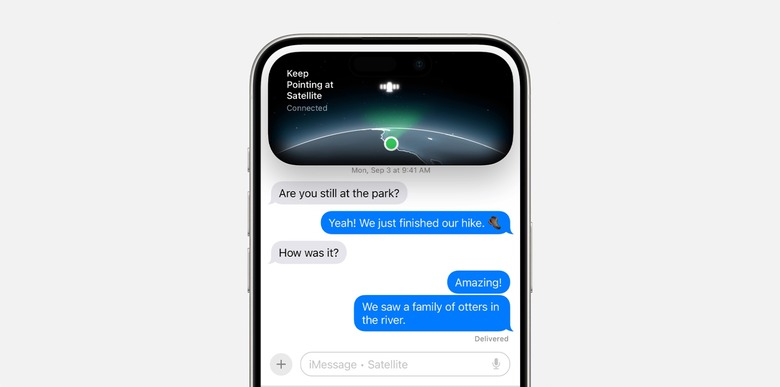Apple's iPhone Satellite Messaging Is 'Literally Saving Lives' Amid North Carolina Flooding
Days after Hurricane Helene ripped through the Southeastern US and killed more than 100 people, several residents are still isolated by destroyed roads and the lack of power and cellular services (via AP). Still, with the new iPhone satellite messaging features available with iOS 18, many people in those affected areas can communicate and get aid.
I've never been more thankful to be an iPhone user.
Due to the lack of cell service, EVERYONE in Asheville NC right now on iOS 18 has been able to get messages out and in with the Satellite messaging feature.
This is literally saving lives @Apple. pic.twitter.com/k0FOIgKlRk
— Matt Van Swol (@mattvanswol) September 30, 2024
On X, photographer Matt Van Swol shared that people in Asheville, NC, have been able to "get messages out and in with the Satellite messaging feature. This is literally saving lives," he wrote. Although it's essential to be in higher areas for the satellite connection to work, Van Swol said it was a 50/50 chance, which is better than nothing.
Another user on X noted the same: "When the power and internet went out at our family's house up the road, we were able to get location pings from the satellite. At least it gave us some peace of mind."
yup! when the power and internet went out at our family's house up there, we were able to get location pings from satellite. at least gave us some peace of mind.
— chris & julie 📐 (@ChrisandJulie) September 30, 2024
Another user has also shared an Apple support document highlighting that the iPhone Text by Satellite option can help even without cellular service.
With iOS 18 recently released, Apple added three more satellite features, following the Emergency SOS via Satellite function introduced with the release of iPhone 14 a couple of years ago.
- Messages via satellite: Message your friends and family directly from the Messages app when your iPhone is off the grid and without cellular or Wi-Fi coverage. When going off the grid, you are immediately prompted to connect to the nearest satellite right from the Messages app to begin messaging over satellite;
- iMessage over satellite: Send end-to-end encrypted texts, emojis, Tapbakc, and replies with iMessage over satellite;
- SMS over satellite: Connect with friends and family who are not on iPhone with SMS over satellite;
- Satellite connection in Dynamic Island: A Live Activity in Dynamic Island will always let you know you are connected to the satellite. Dynamic Island will even help you reconnect when the connection is lost.
These features are available for users in the US and Canada with an active cellular plan and an iPhone 14 or newer. Apple's CEO Tim Cook also tweeted about Hurricane Helene, saying Apple will make a donation to help with relief efforts on the ground.
We're thinking of all those facing the catastrophic aftermath of Hurricane Helene. Apple will be making a donation to help with relief efforts on the ground.
— Tim Cook (@tim_cook) September 30, 2024
Tips and tricks for Messages via Satellite on iPhone
To use Messages via Satellite on iPhone, follow these tips and tricks:
- When you connect to satellite, you'll also see the option to text emergency services using Emergency SOS via satellite, get help with car troubles using Roadside Assistance via satellite, and share your location using Find My via satellite (where these services are available).
- To send a message, just open the Messages app — you'll be prompted to start accepting messages if you haven't already, and your iPhone provides instructions to connect to a satellite to send a text. If you have iPhone 14 Pro or later, the Dynamic Island at the top of the screen has indicator dots that show the strength of your connection and, if your connection could be improved, arrows that direct you to turn left or right. You can tap the Dynamic Island to open Connection Assistant for more help.
- When you connect and start accepting messages via satellite, you'll receive any SMS messages that were sent from your emergency contact or members of your Family Sharing group before you started accepting messages via satellite. You won't receive iMessages until your emergency contact or family member returns to the conversation and taps Send via Satellite underneath their message bubble.
- Messages via satellite might take a little longer to send. In ideal conditions, with a direct view of the sky and horizon, a message might take 30 seconds to send. It might take over a minute to send under trees with light or medium foliage — and you might not be able to connect to a satellite under heavy foliage or if you're surrounded by other obstructions.
- Some Message features aren't supported when using a satellite connection. You can't send or receive photos or videos, audio messages, stickers, or messages in a group message.
- If you can't send an iMessage via satellite—for example, if the person you are trying to text has an iPhone that doesn't have iOS 18, a non-Apple device, or if you haven't sent them an iMessage recently—you can use SMS messaging via satellite.
